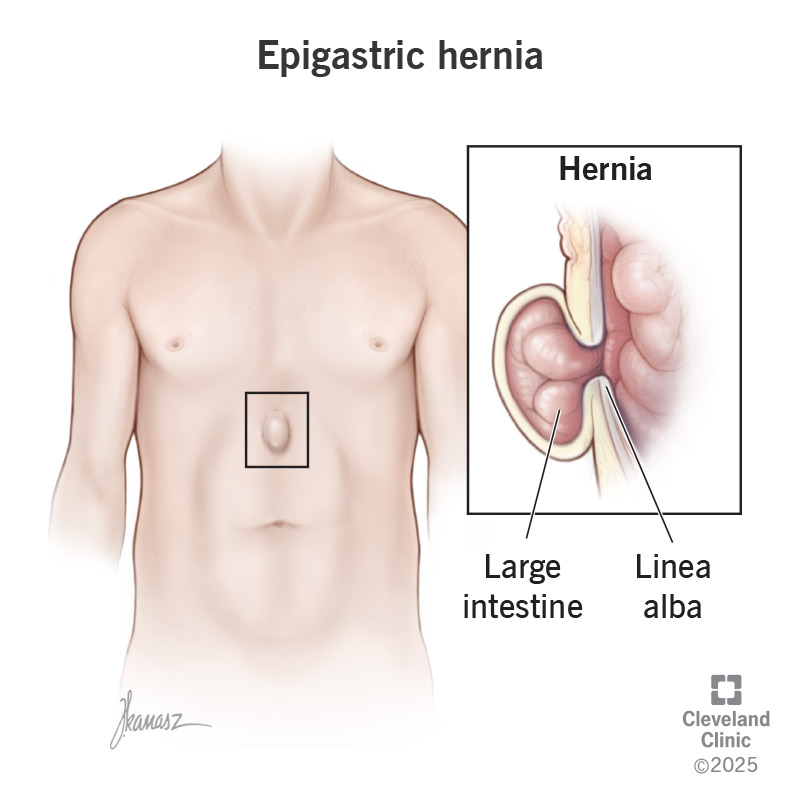An epigastric hernia occurs in the front of your abdomen between your breastbone and belly button. It may not cause symptoms. When it does, symptoms are a bulge that you can see and feel. You may have a dull ache or sharp pain. You may not need treatment. If you do, it’ll be surgery to repair the hernia.
Advertisement
Cleveland Clinic is a non-profit academic medical center. Advertising on our site helps support our mission. We do not endorse non-Cleveland Clinic products or services. Policy

Epigastric (eh-puh-GA-struhk) hernias develop in the upper middle area of your belly (abdomen). They appear in the space below your breastbone and above your belly button. They’re a common type of ventral hernia (a hernia in your front abdominal wall). You can have more than one epigastric hernia.
Advertisement
Cleveland Clinic is a non-profit academic medical center. Advertising on our site helps support our mission. We do not endorse non-Cleveland Clinic products or services. Policy
These hernias are small. They measure less than ½ inch (1 centimeter) or about as long as a staple. Large hernias are 1 ½ inches (4 cm) or about the size of a walnut. You may not have symptoms unless the hernia grows. A large hernia may make a noticeable bulge that you can see and feel.
Epigastric hernias aren’t a serious health condition. But larger hernias may cause life-threatening complications.
An epigastric hernia may not cause symptoms. When it does, symptoms may include:
This condition happens when fatty tissue or a piece of large intestine pushes through your linea alba. This is the thin band of connective tissue that runs down the front of your abdomen. Fatty tissue or intestine may push through a defect (hole) or weak spot in your linea alba. You can develop an epigastric hernia if you have weak abdominal muscles.
You can be born with an epigastric hernia. This hernia forms during fetal development. But these hernias typically develop over time (acquired epigastric hernia). This happens as you get older. It may also happen if you have other issues that put pressure on your linea alba or your abdominal muscles. Epigastric hernias most commonly affect people ages 30 to 50.
Advertisement
Many things can cause an epigastric hernia. Some common causes are:
An epigastric hernia can lead to an incarcerated hernia and a strangulated hernia. Incarcerated hernias and strangulated hernias are serious medical issues. They may be life-threatening.
An incarcerated epigastric hernia is when a hernia gets stuck in your abdominal muscles. It doesn’t move back into your abdomen on its own or when you push on it.
A healthcare provider will do a physical examination. They may do imaging tests to check the hernia’s size and location. Those tests may be:
Hernia repair surgery is the only treatment for an epigastric hernia. But you may not need surgery right away. Your provider may recommend regular checkups instead of surgery if:
That depends on your situation. You may return to work or your daily activities within two weeks. But it may be four weeks before you can go back to work if your job involves lifting heavy things. Everyone’s situation is a bit different. Ask your healthcare provider how long it may take for you to recover from surgery.
Surgery cures an epigastric hernia. But the hernia may come back, or you may develop a new one. That can happen if there’s pressure on your abdominal muscles or your linea alba weakens. Wondering if a hernia will come back? Ask your healthcare provider about the chance that could happen. They may also suggest ways you can reduce that risk.
There are some things you can do to reduce your risk:
Contact your provider if the bulge in your upper belly is getting bigger. Larger epigastric hernias may get stuck (incarcerated hernia) or become strangulated. An incarcerated or strangulated hernia is a medical emergency. Call 911 (or your local emergency service number) or go to the emergency room if you have the following symptoms:
You may want to ask your healthcare provider the following questions:
Advertisement
Acid reflux is a common symptom of a hiatal hernia. An epigastric hernia may cause a dull ache or a sharp pain in your upper abdomen. But it doesn’t cause acid reflux symptoms like heartburn or indigestion.
Talk to a provider if you have a bulge in your upper belly between your breastbone and your belly button. The issue may be an epigastric hernia. But other conditions may cause that bulge. It’s always a good idea to discover the reason for that kind of change in your body. So, your provider will find out what’s behind the bulge and recommend treatment that’s right for you.
Advertisement
Hernias can be painful – Cleveland Clinic’s experts can help. We are leaders in minimally invasive hernia repair, and abdominal wall reconstruction.

Last reviewed on 05/13/2025.
Learn more about the Health Library and our editorial process.